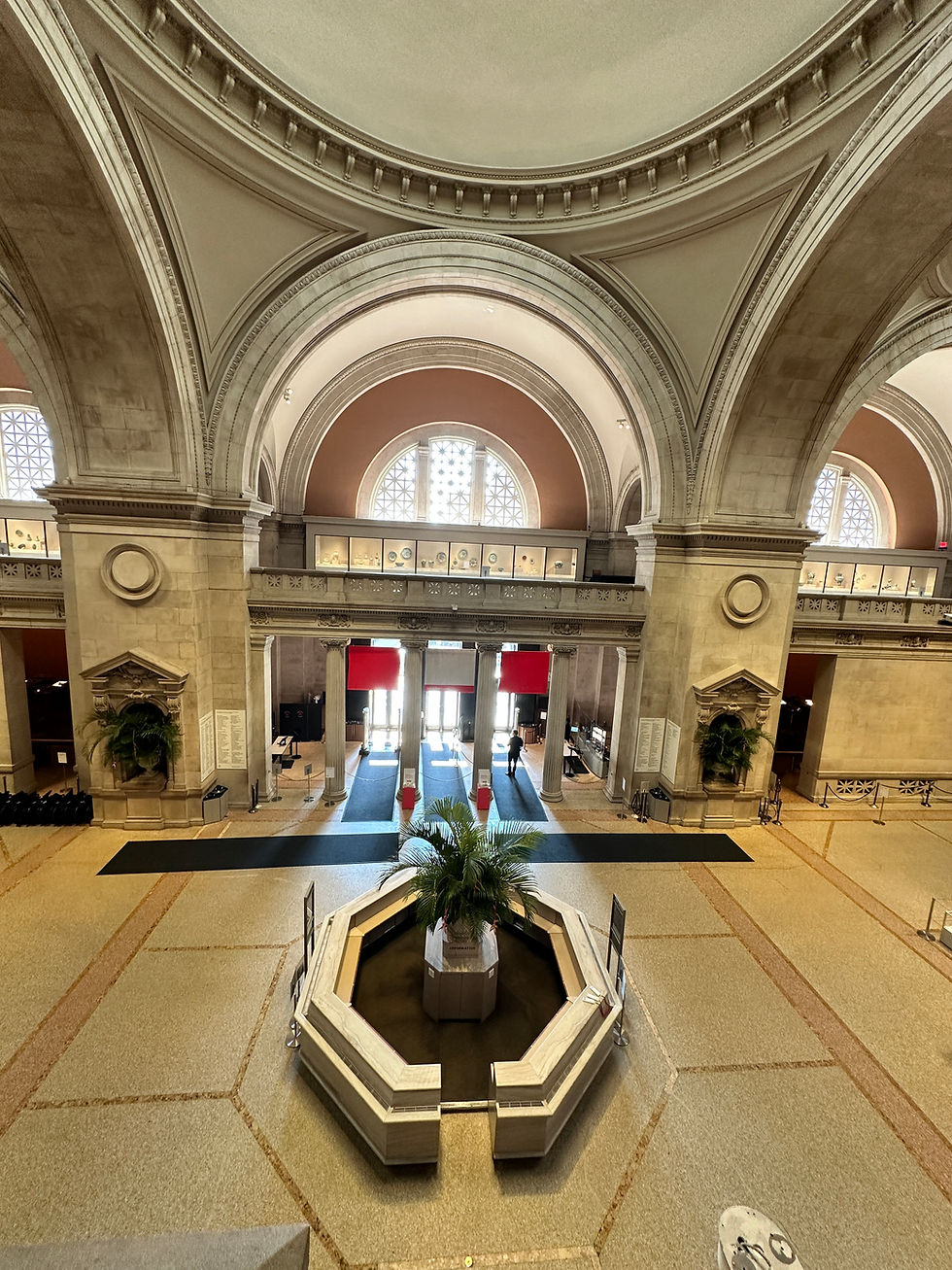When Objects Dream: Man Ray Returns to The Met!
- Maria Yoon
- Aug 29
- 5 min read
Updated: Oct 10

I. Introduction: Step Into the Surrealist Playground
Imagine a world where the mundane revolts. A world where a simple iron sprouts menacing tacks, transforming from a household helper into a symbol of discomfort. A world where the human form is abstracted into elegant shapes by camera-less photography. Welcome to the delightfully twisted mind of Man Ray!
The Metropolitan Museum of Art is poised to plunge headfirst into this dreamscape with "Man Ray: When Objects Dream," opening September 14, 2025.
This isn't just another art show; it's a pilgrimage into the heart of a visionary. A rebel who dared to paint with light (and tacks!), bent reality to his will, challenged artistic norms, and left an indelible, rayographed mark on modern art. Prepare to have your perceptions delightfully destabilized!
II. The Dream Unfolds: What to Expect at The Met's Landmark Show
The main event? "Man Ray: When Objects Dream" will be taking over Gallery 199 at The Met Fifth Avenue, from September 14, 2025, to February 1, 2026. Clear your schedules; this is essential viewing.
Why is it a must-see? This exhibition marks the first major and most comprehensive exploration of Man Ray’s radical experiments across all the artistic disciplines he fearlessly engaged in, with a particular emphasis placed on his revolutionary "rayographs."
Decoding "Rayographs": What are these enigmatic creations that lie at the heart of the exhibition? Imagine sidestepping the camera altogether. Man Ray achieved this by placing objects—keys, combs, bits of lace—directly onto light-sensitive paper, creating ghostly, ethereal compositions through pure light and shadow. As Dada poet Tristan Tzara so eloquently put it, they capture the very moments "when objects dream."
A Feast for the Eyes: Prepare to be overwhelmed—in the best way possible! With over 160 works, the exhibition promises a deep dive into Man Ray's mind. Anticipate encountering approximately 60 iconic rayographs, alongside rarely seen paintings that reveal his painterly origins, provocative assemblages (yes, that iron with tacks will be there!), prints, drawings, and newly restored avant-garde films that showcase his pioneering work with "cine-rayographs."
Iconic Highlights: Keep a sharp eye out for such masterpieces as Violon d'Ingres (that breathtaking photograph of Kiki de Montparnasse, transformed into a violin), Gift (the aforementioned iron, a symbol of surrealist subversion), and the chilling Object to be Destroyed (the ticking metronome with an eye, a meditation on time, loss, and perhaps, the fragility of vision itself).
Behind the Scenes: This ambitious exhibition is curated by Stephanie D'Alessandro and Stephen C. Pinson. Significant support comes from the Barrie A. and Deedee Wigmore Foundation, with additional support provided by the fashion house Schiaparelli, a fitting tribute to the remarkable creative friendship between its founder, Elsa Schiaparelli, and Man Ray.
III. The Rebel Who Painted with Light (and Tacks): Man Ray's Wild Ride Through Art History
From Emmanuel to Man Ray: Let's take a brief look at the man behind the myth. Born Emmanuel Radnitzky in Philadelphia, he was, at his core, a painter. This exhibition acknowledges that initial artistic impulse, the foundation upon which his later, more radical experimentations were built. But destiny, and perhaps a touch of rebellion, had other plans.
Dada, Surrealism & Beyond: Man Ray played a pivotal role in the raucous Dada movement in New York alongside Marcel Duchamp, challenging the very definition of art with irreverence and wit. In 1921, he moved to Paris, where he became the only American at the heart of the Surrealist revolution, a group of artists who sought to unlock the power of the unconscious mind.
The Accidental Genius: Serendipity often plays a crucial role in artistic innovation. In 1921, a darkroom accident led him to stumble upon the rayograph technique, a discovery that would change the course of photography forever.
Beyond Rayographs: Man Ray's genius extended far beyond the rayograph. Explore his other groundbreaking techniques, such as solarization (famously explored in collaboration with his lover and muse, Lee Miller), which added an ethereal, almost dreamlike quality to his photographs.
Objects with Attitude: His "readymades" were far more than just found objects. They were philosophical jabs, intended, as he himself stated, "to amuse, annoy, bewilder, mystify and inspire reflection." Consider The Gift and Object to be Destroyed – art that transcends mere aesthetics, forcing us to confront uncomfortable truths about ourselves and the world around us.
The Multihyphenate: He seamlessly transitioned between roles as a painter, object-maker, avant-garde filmmaker (pioneering "cine-rayographs"), and even a sought-after high-fashion photographer for Vogue and Schiaparelli. It's worth noting that Man Ray often viewed his commercial work as a necessary evil, a means to fund his "real" artistic pursuits. A pragmatic approach to maintaining his artistic freedom.
IV. Beyond the Frame: Man Ray's Enduring Impact & Lingering Questions
From Misunderstood to Millions: Man Ray’s reputation has undergone a dramatic transformation over time. Once an acclaimed but sometimes critiqued artist, his work now commands record-breaking prices. Remember Violon d'Ingres selling for a staggering $12.4 million in 2022? A testament to his enduring legacy.
Elevating the "Snapshot": He played a crucial role in elevating photography from a mere documentary tool to a respected and experimental art form. He dared to challenge the established order, pushing the boundaries of what photography could be.
Pop Culture Penetration: His imagery continues to permeate contemporary aesthetics. From tattoo designs directly inspired by the f-holes in Violon d'Ingres to fashion collections that echo his iconic style, his influence is undeniable.
Controversies & Provocations:
· "Crimes Against Photography": Man Ray himself playfully described his experimental techniques as literal "crimes against chemistry and photography," highlighting his willingness to break the rules and defy convention.
· The Painter's Predicament: Throughout his life, he grappled with an internal debate: was he primarily a painter, or a photographer? Critics sometimes missed the genius of his fluidity across mediums, failing to appreciate the interconnectedness of his artistic endeavors.
· Personal Shadows: It is essential to acknowledge the biographical examinations surrounding Man Ray, including his deliberate distancing from his Jewish heritage and criticisms regarding the portrayal of women in some of his works. The Object to be Destroyed, featuring Lee Miller's eye, is often cited within this context, raising questions about agency, representation, and the complex relationship between artist and muse.
V. What's Next for the Dreamer? Future Visions
The Met Show Leads the Charge: "Man Ray: When Objects Dream" stands as a pivotal moment for rediscovering the full breadth of his genius, solidifying his place as a central figure in 20th-century art.
Global Influence: Another major retrospective, "Man Ray. Forms of Light," opening simultaneously in Milan, underscores his ongoing international relevance, demonstrating that his work continues to resonate with audiences worldwide.
Inspiring the Next Generation: His experimental spirit continues to fuel contemporary artists, photographers, and major fashion designers (think Yves Saint Laurent, Martin Margiela, and the revitalized Schiaparelli brand of today). His legacy is one of innovation and boundless creativity.
A Legacy That Keeps Evolving: Man Ray's work remains a vibrant source of inspiration, challenging us to look beyond the obvious, question our perceptions, and embrace the dreamlike potential that lies within the everyday.
VI. Don't Just Dream It, See It!
Mark your calendars! "Man Ray: When Objects Dream" promises to be an unforgettable experience. This is a rare chance to immerse yourself in the full breadth of Man Ray's genius and witness the birth of a new artistic vision.
What's your favorite Man Ray piece? Are you excited to see his rayographs up close and personal? Share your thoughts and anticipations in the comments below! Let's explore the dreamscape together!





Comments